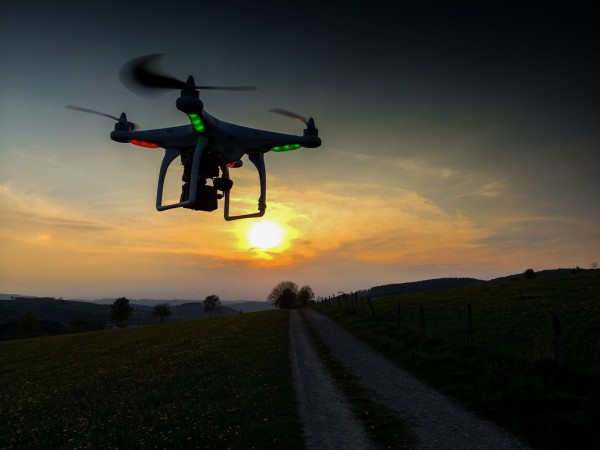Drones were among the most popular Christmas gifts in 2014 — so popular, in fact, that British authorities warned recreational drone users to make sure to use their toys lawfully, or to expect hefty fines. Similarly, the US FAA released a video just before the holidays, teaching aspiring drone users how to “stay off the naughty list”. More and more people are becoming familiar with drones as the number of ‘hobby droners’ (yes, this is a term) grows. Businesses are discovering drones as well: drones carry mistletoe in restaurants (with questionable results), or are used to give real-estate buyers a better view of their property. Beyond this, hundreds if not thousands of commercial drone users are waiting in the wings for a few last technical details to be figured out (especially sense-and-avoid technology) and for the implementation of legal regulations allowing drones to share airspace with manned aircraft.
These developments are exciting, but they are also interesting for those working with military drones. The widespread use of drones for commercial purposes is likely to increase awareness about the history and the many applications of drones, which may help to overcome their exclusive association with targeted killings.
A long history
Initially, the development of unmanned aerial vehicles (UAV) was an exclusively military affair; only in recent times have civilian drone developers started to appear on the scene. Depending on how one defines drones, their history goes back centuries. Many authors consider hot-air balloons, which were developed in the late 16th century, to be the first step towards modern UAVs. These were first used for military purposes when the Austrians attacked Venice in 1849, using unmanned balloons equipped with explosives controlled by time fuses. These balloons, of course, could not be remotely controlled, and backfired when they were blown back over the Austrian lines.
A further step towards modern drone systems was the ‘Kettering Bug’, developed by the US military in the final stages of WWI. The ‘Bug’ was a 4-meter long biplane that carried an 80 kg warhead and resembled a missile more than a drone. Some time after launch, the engine would shoot off, the wings would be released, and the Bug would plunge to earth and detonate on impact. The ‘Bug’ is considered a precursor of today’s drones because the development of drones and missiles took place simultaneously. Advances in one system influenced those in the other. This also explains why ambiguities regarding definitions still exist. Some modern systems such as so-called “kamikaze drones” are difficult to classify, resembling drones as well as missiles.
A milestone for UAV development was the introduction of the Gyrodyne QH-50 DASH (Drone Anti-submarine Helicopter) in the early 1960s. The ‘Dash’ was a vertical take-off UAV which could fly from the deck of smaller ships. Armed with two torpedoes, it was used by the US Navy to fight enemy submarines. Unlike the ‘Kettering Bug,’ the ‘Dash’ could be piloted remotely and was recoverable; it can thus be considered the first real armed drone.
The heyday of drone development began following the 1982 Lebanon War. Israel’s successful use of drones to destroy enemy surface-to-air missiles attracted a lot of attention. Thereafter, armed forces around the world, particularly in the US and Israel, began to invest heavily in unmanned systems. As this development coincided with technical advances such as the development of GPS and better data-storing and camera techniques, interest in drones began to take off. Particularly in the last decade, drones have become a must-have item for armed forces around the world. Today, 76 countries are known or suspected to have military drones at their disposal.[1]Drones have been used in military operations in Afghanistan and Iraq, Kosovo and Georgia, Libya and Mali as well as in many other places. Drones have firmly established their place in modern military operations.
An image problem
Contemporary armed forces consider drones to be among the most useful military inventions of modern times, but the general public has been less enthusiastic. This is because most people became aware of drones only recently and in one specific context: their use by the CIA for targeted (or not so targeted) killings in Pakistan, Yemen, and Somalia.
These strikes and the roughly 3000 deaths they have caused have created legitimate opposition to these policies. Nevertheless, although most of the critiques are directed against this specific use of drones, they have led many people to oppose drones in general.
In fact, drones have a terrible public image. Terms such as ‘killer robots’ andreferences in the media to the Terminator contribute to this, and growing concernsregarding the rising level of automation only make matters worse.
For armed forces and defence ministries around the world, this is a very real problem and can have direct consequences for military procurement and drone use. Consequently, many are increasingly trying to improve drones’ image. For instance, the British MoD recommends that when “working with an uninformed audience” or “when talking to the media” not to use the term ‘unmanned’ but, instead, ‘remotely piloted aircraft’ – which emphasises that drones are still controlled by soldiers.
The growing recreational and soon-to-be commercial use of drones is likely to play into the hands of efforts such as these to improve the image of drones. While the most common association with the term remains a Predator-like ‘killer’ drone, tomorrow’s associations are likely to be more positive – of a toy drone used to take drone selfies (or ‘dronies), or of a ‘burrito bomber’ , rather than an actual one. Militaries around the world will be rather happy about this.
Ulrike Esther Franke is a DPhil student in International Relations, supervised by Professor Hew Strachan. In her work she focuses on the strategic implications of the increasing use of Unmanned Aerial Vehicles (UAVs or “Drones”) by Western armed forces. She is interested in the impact of military technology on warfare and the so-called “Revolution in Military Affairs”.
She is the Managing Editor of the St. Antony’s International Review (STAIR), Oxford University’s journal of international affairs. Ulrike is also part of UN Special Rapporteur on human rights and counter-terrorism Ben Emmerson’s research team, working on drone use in counterterrorism contexts. In the past, she has worked as a part-time research assistant for military aerospace at the International Institute of Strategic Studies (IISS) in London (May 2012 – January 2013).
This post originally appeared on the website of The International Relations and Security Network. For more information on issues and events that shape our world, please visit ISN Security Watch or browse their resources.
[1] The exact numbers and an explanation of the methodology can be found at Franke, Ulrike Esther. “The Global Diffusion of Unmanned Aerial Vehicles (UAVs), or ‘Drones’”. In Precision Strike Warfare and International Intervention: Strategic, Ethico-Legal and Decisional Implications, edited by Mike Aaronson, Wali Aslam, Tom Dyson and Regina Rauxloh: Routledge, 2014. (Information as of September 2013).









No Comment